Smart Gauges to Combat Asymmetric Threats
In search of the smartest
The presence on board a combat vehicle of a large number of different types of ammunition, on the one hand, allows you to hit various types of targets, and on the other, seriously increases the mass of transported ammunition. It is worth considering the loss of time to recharge weapons the corresponding projectile. In addition, the cost of "stupid" shells on a target is often outweighed in the final cost by single and effective shots of "smart" ammunition. This is especially true of modern asymmetric threats, when many miniature Davids are able to turn any Goliath into scrap metal. UAVs with mini-bombs, mobile mortar crews, speedboats armed with both rocket weapons and simply equipped with a couple of hundred kilograms of explosives with a fanatic on board - all these irritants force us to look for technological answers in all developed countries of the world. Demand, as you know, creates supply, and now we are witnessing a process of gradual increase in the "intellectual" capabilities of artillery weapons - primarily in the niche of small and medium calibers.
The fact that it was time to get rid of classic fragmentation munitions was first discussed in the 60s of the last century, when it became possible to conduct a detailed study of the physics of a shell explosion. It turned out that the fragmentation grenades during the explosion form too low a density of fragments, some of which also goes into the air and soil. Even non-contact fuses, if they change the situation, are not dramatic: some fragments still fly past the target. The formation of a fragmentation field was actually random, with a negative effect introduced by longitudinal cracks on the shell of the projectile, which formed in the first moments of the explosion. They formed long and heavy fragments, called "sabers", which accounted for up to 80% of the entire mass of the body. They tried to find a way out in the search for the optimal composition of steel, but this path turned out to be in many ways a dead end. Shells of shells with predetermined crushing parameters, which also seriously reduced strength, led to higher production costs. Failed and not the most perfect shock fuses, which showed themselves not from the best side in the flooded rice fields of Vietnam, the deserts of the Middle East and the marshy soils of the lower Mesopotamia. Therefore, the engineers decided to revive shrapnel ammunition, which they successfully buried before the Second World War. In the 60s, new targets for artillery appeared - the calculations of anti-tank weapons, soldiers protected by individual armor, as well as the birth of the first small-sized air targets such as anti-ship cruise missiles. To help shrapnel ammunition came new alloys based on tungsten and uranium, significantly increasing the breakdown effect of ready-made striking elements. So, the Americans, sophisticated in matters of improving the effectiveness of their weapons, in Vietnam for the first time used ammunition with arrow-shaped striking elements, each of which weighed from 0,7 to 1,5 grams. Each projectile had up to 10000 wax-filled arrows, which, when detonated by a knock-out charge, accelerated to 200 m / s. To accelerate arrows to a higher speed was dangerous: there were great chances of destruction of elements from a powerful explosion.
Gradually, the evolution of a new type of shrapnel led to the emergence of small-caliber ammunition for 20-mm guns. This was the German DM111 projectile for the Rh202 and Rh200 guns weighing 118 grams. and containing 120 balls, each of which pierced a duralumin sheet 2 mm thick. In Russia, a 30-mm projectile was intended for similar work, in which there were 28 bullets of 3,5 grams each. each one. This ammunition was developed for aviation guns GSh-30, -301, -30K; its distinguishing feature was the fixed interval of the actuation of the expelling powder charge (at a distance from 800 to 1700 m), from which the shrapnel bullets flew at an angle of 8 degrees.
Probably one of the most advanced shrapnel ammunition was the Swiss AHEAD from Oerlikon - Contraves AG with a caliber of 35 mm, which has certain rudiments of a simple artillery "intelligence". In the bottom of the projectile is an electronic remote fuse that fires at a strictly defined time. For this, artillery installations capable of firing such ammunition must have a rangefinder, ballistic computer and a muzzle input channel for a temporary installation. The input channel or induction programmer is three solenoid rings, the first two of which measure the projectile departure speed, and the third passes the detonation time parameters to the remote fuse. At a muzzle velocity of the projectile of about 1050 m / s, the entire process of measuring muzzle velocity, calculating and programming the projectile takes less than 0,002 seconds.
AHEAD anti-aircraft projectile (Advanced Hit Efficiency And Destruction - “increased hit and destruction efficiency”), exploding 152 finished tungsten cylinders, allows you to fight aircraft, UAVs and missiles at a distance of up to 4 km. Typical examples of gun systems using Swiss shells are MANTIS, Skyshield and Millennium, equipped with a 35 mm Oerlikon 35/1000 automatic cannon. In particular, guns are capable of firing in three modes: classic single and single with a rate of 200 rounds per minute, as well as bursts of 1000 rounds per minute. AHEAD were developed back in the 90s, survived many modernizations and actually became the founder of a whole new class of KETF shells (Kinetic Energy Timed Fuze, kinetic energy ammunition with a temporary fuse, often referred to as AHEAD / KETF or ABM / KETF).
Caliber is fading
While the 35mm AHEAD seems too large, Rheinmetall offers the 308mm PMC30 smart ammunition already used in NATO countries. Such shells can seriously save volumes for ammunition. The developers claim that up to 50% compared with 35 mm and up to 75% in the case of 40 mm. The shells fit the guns Rheinmetall MK30-2 / ABM1 and Wotan, named after Wotan, the supreme ancient German deity. It will not be a problem to use a shell with guns that have a programmer not on the muzzle, but in the munition supply mechanism. For example, in a 30-mm gun Mk44 Bushmaster II company Orbital ATK. The PMC308 is a projectile stuffed with 162 striking elements, each weighing 1,24 grams. In case of a miss, the “smart” ammunition self-destructs after 8,2 seconds of flight, managing to overcome 4 km during this time.
Perhaps the most high-tech device in the described technique is a miniature bottom fuse, unified for both 35 mm and 30 mm AHEAD / KETF. It consists of a receiving coil of a non-contact programmer, an electronic temporary device with an energy source, an electric fuse, a safety-executive mechanism with a detonator, and an expulsion charge containing 0,5 g of explosives. In this case, the power source generator starts when overloaded from a shot - this allows you to save energy consumption in standby mode in the combat unit. Electronics has an interesting fuse, which does not allow programming undermining less than 64 ms after departure from the trunk. This creates a "safety zone" from being hit by its own fragments around a gun with a radius of about 70 meters. And, of course, the absence of a contact fuse allows an automatic gun to work on a target through bushes and dense thickets of vegetation. And, most importantly, the 30 mm and 35 mm AHEAD / KETF shells are dual-mode. The first is a mode with a programmed range of detonation, and the second is generally without programming. That is, an expensive projectile can pierce a 24-40-mm brick wall only due to kinetic energy. In this case, the ammunition is destroyed, scattering the deadly contents already beyond the barrier.
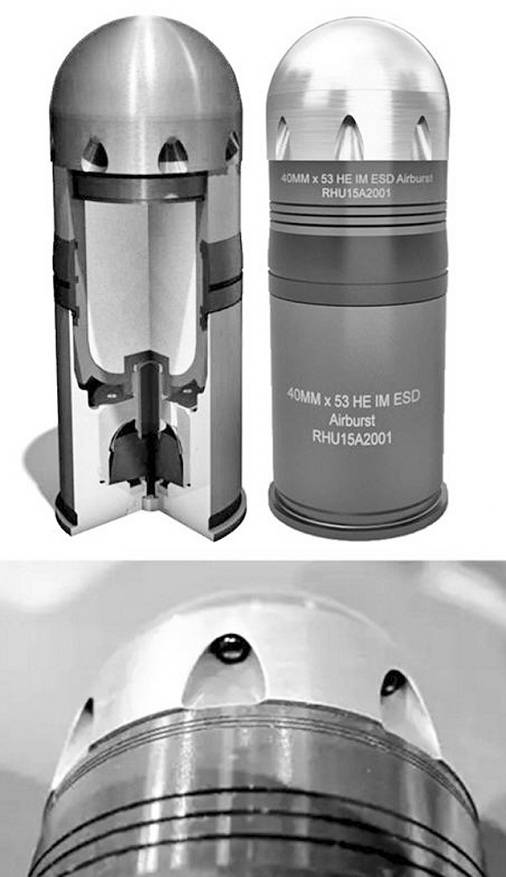
By the way, programmers on the muzzle and in the ammunition supply mechanism are not the only options for "communication" between the gun and the shells. Rheinmetall has developed a 40-mm high-explosive fragmentation round DM131 HE IM ESD-T ABM for the German Heckler & Koch GMG grenade launchers and the American General Dynamics Mk 47 Striker. A special feature is the Vingmate 4500 (Vingmate Advansed) fire control system, the principle of operation of which is similar to the flight correction of an anti-tank missile. Only here, with the help of coded infrared signals, the time of the explosion in the air is transmitted to the grenade, which has already managed to overcome 4 m from the muzzle in flight.
At the same time, the grenade, which accepted its command for execution through eight on-board IR receivers, can no longer be reprogrammed in order to avoid receiving someone else's command. Here, as in the case of AHEAD, a burst from a Heckler & Koch GMG grenade launcher can be used to create a spectacular "pearl string", that is, to simultaneously detonate several grenades along the flight path. To implement such a complex mechanism of operation on a grenade launcher, a laser rangefinder and an infrared programmer searchlight with a control unit must be installed.
50mm EAPS Ammunition
To deal with attacking artillery shells, mines and explosive-filled balloons of “smart” shells of 20, 30 and 35 millimeters caliber are often not enough. To solve such problems, a 50-mm gun Enhanced Bushmaster III was created, which can also be performed in a 35-mm version.
The gun was originally developed as part of the EAPS Extended Area Protection and Survivability program, whose leadership is assigned to the US Army Research, Development and Design Center. Of course, a caliber of 50 mm implies the presence of armor-piercing shells, but the main thing is the ammunition AirBurst (AB) SuperShot 50 mm PABM-T, equipped with a remote air-blasting system. At first it was believed that the new gun would fit on the upgraded version of the Bradley, but there was not enough space in the BMP for such an ammunition gun, so it was decided to use the promising NGCV (Next Generation Combat Vehicle) as a platform.
The gun, by the way, on the Griffin III Demonstrator prototype lifts itself almost vertically into the sky (up to 85 degrees), clearly demonstrating what goals can be a priority.
To successfully control the fire of such a powerful gun on air targets such as asymmetric threats, the development of EAPS now has an interferometric radar station capable of tracking 6 targets at once and controlling the movement of ten 50-mm munitions toward them. The target is fired at by the twin Enhanced Bushmaster III on a wheeled chassis.
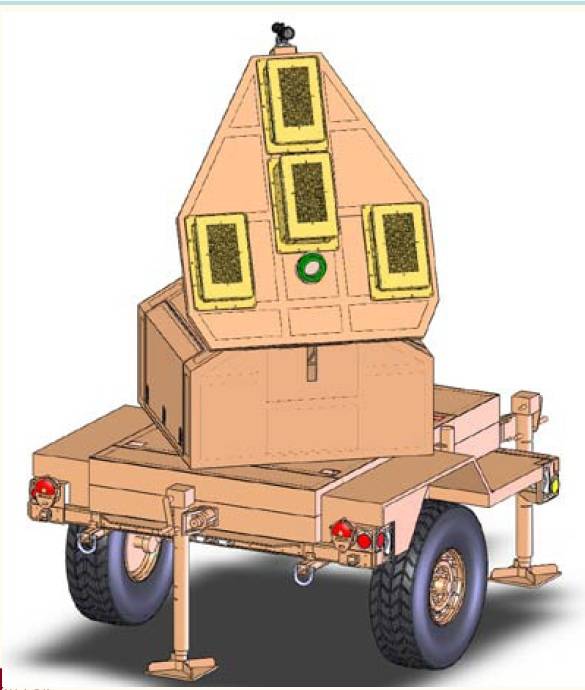
It is interesting that initially, in 2007, the Americans from the developer of the Texton Systems company calculated that the most optimal form of the projectile would be a classic animated one with a six-blade tail. But tests showed that such a scheme does not differ in flight stability, and the cylindrical tip of the munition was equipped with a needle. In addition, a monopulse correction engine containing 5,9 cm was located in the region of the center of mass of the projectile3 fuel and creates, if necessary, an impulse perpendicular to the axis of the projectile. That is, this “smart” projectile can not only explode at the right time by radio commands from the ground, but also adjust its flight to the target. And this, I recall, in the form factor of the 50-mm shell of an automatic gun.
The next innovation of the EAPS gun can be considered the cumulative-fragmentation warhead MEFP (Multiple Explosive Formed Penetrator), which forms a directional field of 7-12 miniature tungsten-tantalum “impact cores” when undermining. This turned out to be a necessary measure in the fight against thick-walled mines, against which ordinary tungsten shrapnel is ineffective. In addition, explosives form a circular field from fragments of a previously fragmented shell of the shell - this is for more vulnerable drones.
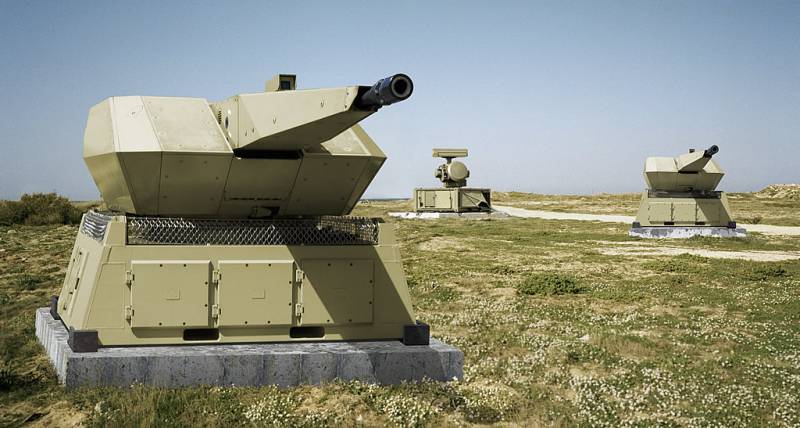
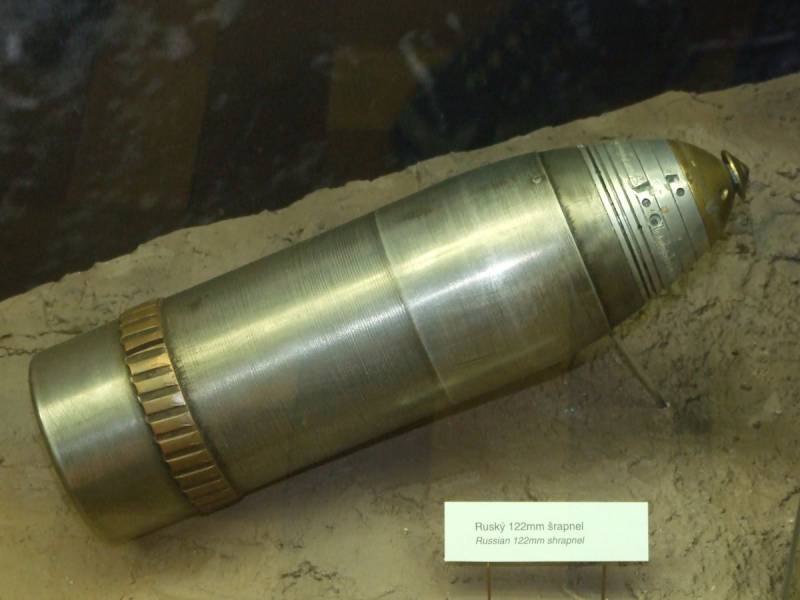
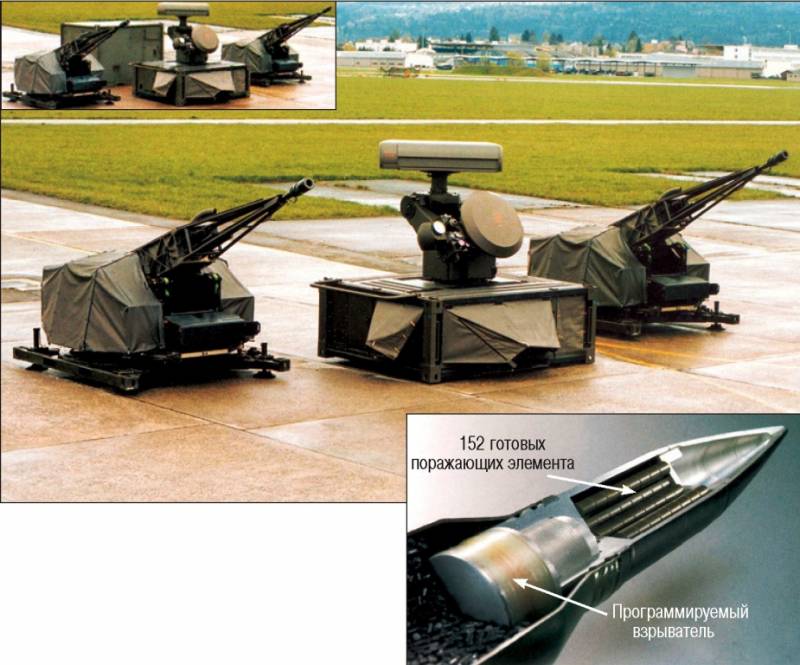
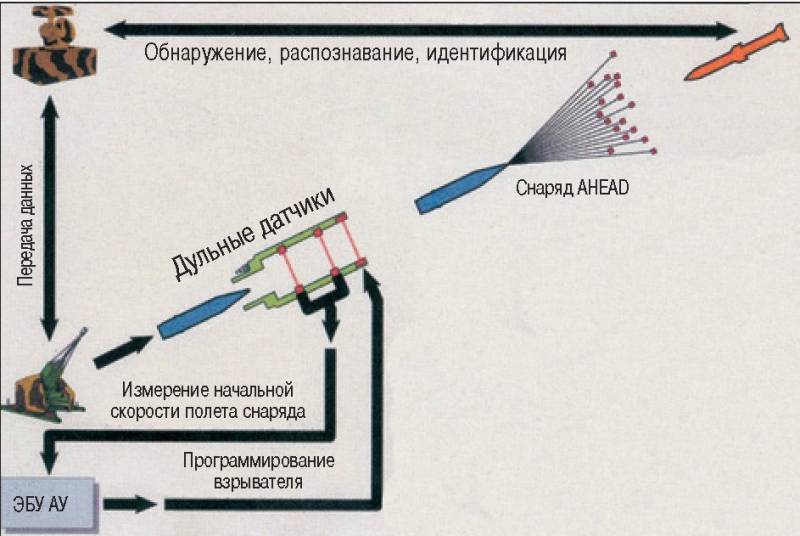
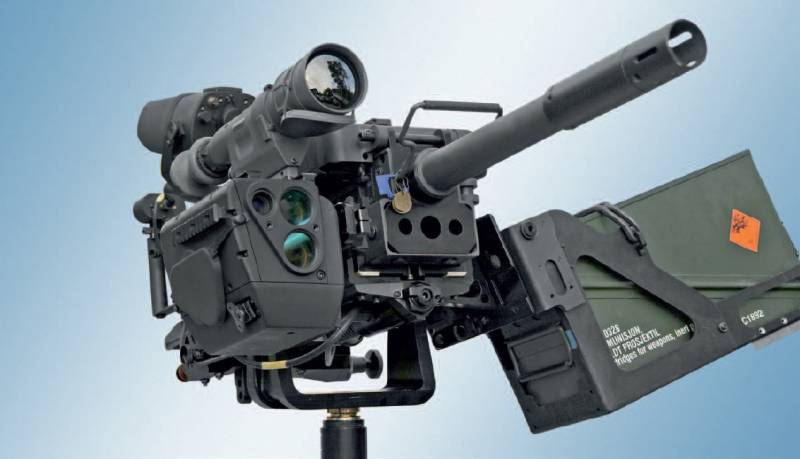
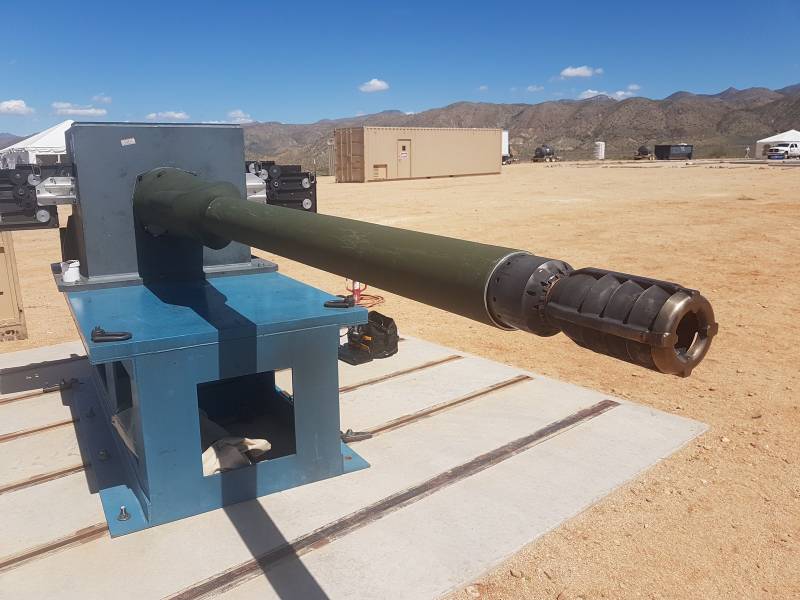
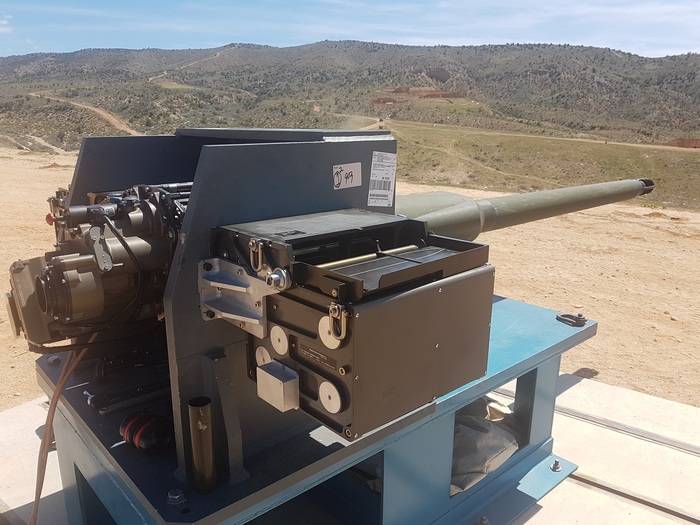
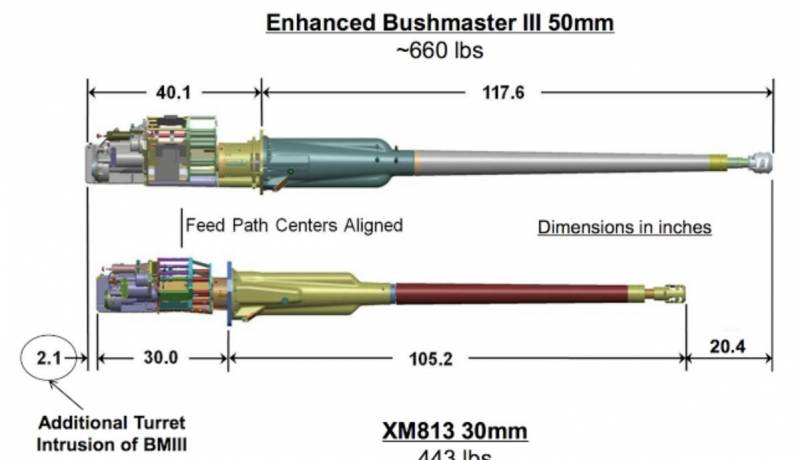
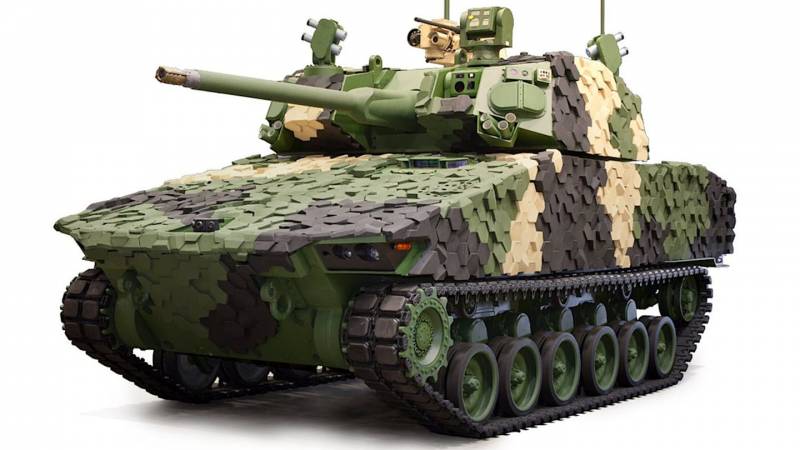
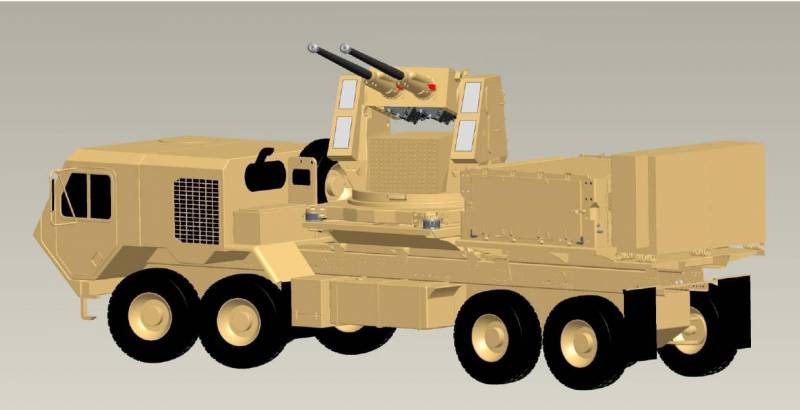

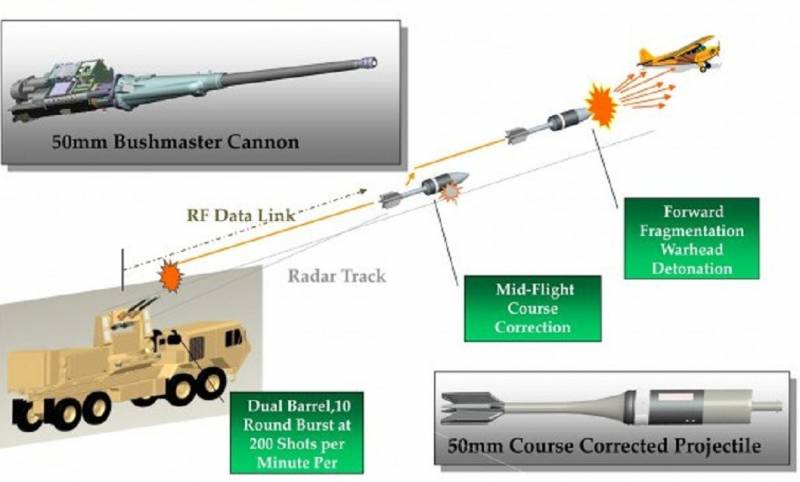
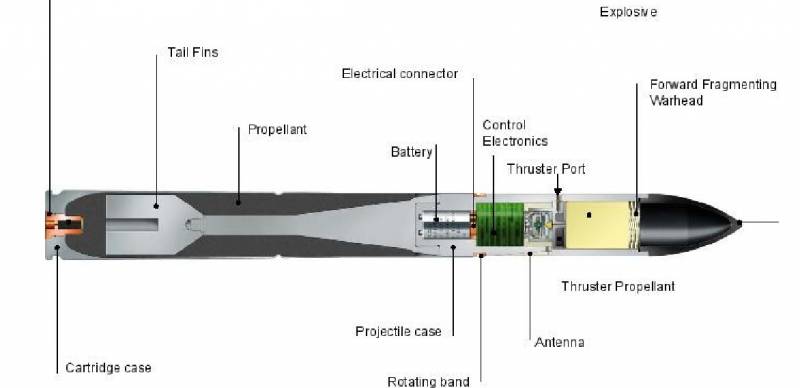
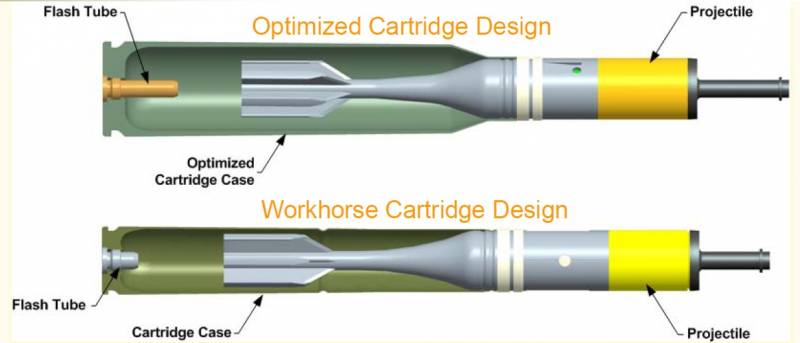

Information